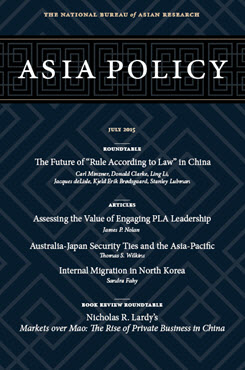Legal Reform in the Xi Jinping Era
This essay is part of the roundtable “The Future of ‘Rule According to Law’ in China.”
Carl Minzner is a Professor at Fordham Law School, where he specializes in Chinese law and governance.
In the fall of 2014, Chinese Communist Party authorities made legal reform the focus of their annual plenum for the first time. The Fourth Plenum Decision confirmed a shift away from some of the policies of the late Hu Jintao era, but liberal reforms still remain off the table. The top-down vision of legal reform developing under Xi Jinping’s administration may have more in common with current trends in the party disciplinary apparatus or historical ones in the imperial Chinese censorate than it does with Western rule-of-law norms.
This essay attempts to do three things: (1) analyze how and why China’s legal reforms have shifted over the past two decades, (2) outline the direction of reform under Xi, and (3) sketch out the institutional considerations that are likely to steer state efforts in the legal field over the coming years.
The Turn Against Law
In the first decade of the 21st century, Chinese Communist Party authorities turned against many of the legal reform efforts that they themselves had launched in the 1980s and 1990s. Starting around 2005, a new official line began to gradually penetrate China’s judicial and legal organs. Broadly speaking, this position included the following:
- A shift away from late 20th-century efforts to promote judicial professionalism, coupled with a revival of 1950s Maoist-era ideals of judicial populism
- A revived focus on mediation, rather than court trials, as a preferred mechanism for resolving conflicts among citizens as well as between citizens and the state
- A new state narrative depicting the law as cold and unresponsive to citizen needs
- A stress on the courts as an undifferentiated cog within the state organs for stability maintenance (weiwen)
- A steady reduction in tolerance for the activities of public interest (weiquan) lawyers
- A new political campaign reiterating party supremacy over the constitution, law, and courts
- The charging of local officials with the priority task of containing citizen disputes, conflicts, and petitions at all costs
Central authorities employed multiple tools to implement these shifts. Some were highly public—for example, the 2008 appointment of a veteran security apparatchik as the new head of the Supreme People’s Court, the 2009 police raid on the Open Constitution Initiative, and the subsequent repression of public interest lawyers such as Xu Zhiyong and Teng Biao. Other tools were less visible. New propaganda campaigns within the courts presented changed depictions of “model” judges to emulate: tireless court officials perhaps lacking in book learning but at ease among the masses, recognizant of parties’ emotions, and able to resolve disputes (often without resort to legal norms) before they blossomed into conflict. Personnel evaluation systems for judges and other officials were tweaked to emphasize mediation rather than adjudication.
About Asia Policy
Asia Policy is a peer-reviewed scholarly journal presenting policy-relevant academic research on the Asia-Pacific that draws clear and concise conclusions useful to today’s policymakers. Asia Policy is published quarterly in January, April, July, and October and accepts submissions on a rolling basis. Learn more


